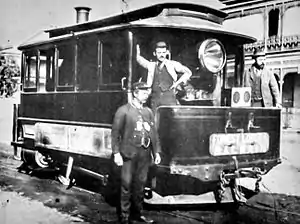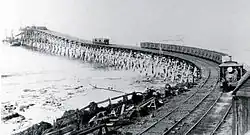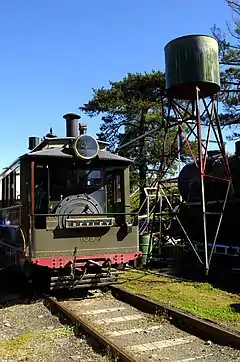| NSWGT Steam Motor Trams (Sydney) | |
|---|---|
 Baldwin Tram Motor No. 7 at Balmain, New South Wales | |
| Manufacturer | Baldwin Locomotive Works Randwick Tramway Workshops Henry Vale T. Wearne |
| Designer | Baldwin Locomotive Works |
| Constructed | 1879-1923 |
| Number built | 123 |
| Specifications | |
| Train length | 17 feet 2 inches (5.23 m) |
| Width | 8 feet 6 inches (2.59 m) |
| Maximum speed | 20 km/h |
| Weight | 14 t 2 cwt |
| Track gauge | 4 feet 8+1⁄2 inches (1,435 mm) standard gauge |
The Sydney Steam Motor Trams were built for and operated by the New South Wales Government Tramways of Australia.
History
Steam trams were introduced when four steam tram motors imported to Sydney as a temporary transport for the International Exhibition of 1879. It was built at the Baldwin Locomotive Works, Philadelphia, United States and hauled double decker trailers conveying passengers from the Redfern railway terminus to near the Botanic Gardens. [1]
A Beyer, Peacock & Company steam tram of 1885 was sent to Australia in 1886 as a trial unit by the New South Wales Government Tramways (NSWGT) for comparison against the Baldwin steam tram. The Baldwin design prevailed and this engine returned to England in 1889 to become Beyer Peacock works shunter No. 2. The engine is rumoured to have fallen into the sea on its return voyage,[2] but it survived and is still in working order and known as 'John Bull'.[3] Some sources show it as numbered '47' in Sydney, but number 47 had already been allocated around 1883.
Design
The steam tram motor is essentially a small enclosed saddle tank locomotive steam motor with four driving wheels in an 0-4-0 arrangement. A wooden cab encloses the entire locomotive, which features five windows along each side. Access to the cab is through doors from either the front or back platform. The tram is powered by an orthodox locomotive type boiler, American bar type framing, conventional "D" type slide valves and spring suspension. Coke and later coal was carried in a bunker on the rear platform and water in the semi-circular saddle tank.
Typical specifications for an 11" Baldwin steam tram motor:
- Cylinders: 11" diameter x 16" stroke
- Tractive Effort: 120 psi steam, 5,500 lb at 10 mph
- Weight: 14 tons 2 cwt
- Length: 17 feet 2 inches
- Width: 8 feet 6 inches
Service
.jpg.webp)
The Redfern to Botanic Gardens tramway was planned to operate for the duration of the exhibition. Proving so popular an extension to Randwick was opened in 1880. The peak of steam working was reached during 1894, when the length of the tramway reached 40 miles (64.7 km) when there were over 100 steam trams in service. In 1905-6 steam tram routes were replaced by electric trams with steam trams gradually relegated to outer suburbs.
Government tram lines in Sydney that were never converted to electric tram operation were the Kogarah to San Souci line, the Arncliffe to Bexley line, the Sutherland to Cronulla line, and the line from Parramatta to Castle Hill. There was also a privately-operated line from Parramatta Park to Redbank Wharf, which only operated using steam tram motors, until it closed in 1943.[4]
Steam tram motors also operated on regional New South Wales tramways at Newcastle,[5] Maitland,[6] and Broken Hill.[7] Steam tram motors, with railway contour wheels, were used on the East Maitland–Morpeth railway line, between 1895 and 1915.
The Steam Tram Motors in service were:
| Steam Tram Motors | ||||||||
|---|---|---|---|---|---|---|---|---|
| Builder | Date | Cyl Diam. | Original Nos. | Total | ||||
| Baldwin | 1879 | 11 inch | 1-4 | 4 | ||||
| Baldwin | 1880 | 11 inch | 5-10 | 6 | ||||
| Baldwin | 1881 | 10 inch | 11, 13, 15-18, 26 | 7 | ||||
| Baldwin | 1881 | 11 inch | 12, 14, 19-25 | 9 | ||||
| Baldwin | 1881 | 9 inch | 27-30 | 4 | ||||
| Baldwin | 1882 | 9 inch | 31-33 | 3 | ||||
| Baldwin | 1882 | 11 inch | 34-41 (*) | 8 | ||||
| Baldwin | 1882 | 10 inch | 44, 45 | 2 | ||||
| Baldwin | 1883 | 10 inch | 46, 47-49, 51-54, 56, 57 (**) | 10 | ||||
| Baldwin | 1884 | 11 inch | 58-69 (***) | 12 | ||||
| Baldwin | 1885 | 11 inch | 77-96 | 20 | ||||
| Baldwin | 1891 | 11 inch | 76 (2nd), 97, 98-110 | 15 | ||||
| Henry Vale | 1890 | 11 inch | 50 (2nd), 70 (2nd), 75 | 7 | ||||
| Henry Vale | 1891 | 11 inch | 5 (2nd), 12 (2nd), 13 (2nd), 27 (2nd), 28 (2nd), 76 (2nd) | 6 | ||||
| T. Wearne | 1884 | 10 inch | 76 | 1 | ||||
| T. Wearne | 1886 | 10 inch | 97 (2nd) | 1 | ||||
| Randwick Workshops | 1916 | 11 inch | 126A-128A | 3 | ||||
| Randwick Workshops | 1917 | 11 inch | 129A, 130A | 2 | ||||
| Randwick Workshops | 1923 | 11 inch | 131A, 132A | 2 | ||||
| Randwick Workshops | 1957 | body only built for processions | 1 | |||||
(*) Numbers 42 and 43 were two Kitson steam motors,[8] ordered in 1881,[9] that were unreliable in service.[10]
(**) Number 55 was an experimental steam motor, made by Merryweather & Sons, that arrived in 1881.[11][12]
(***) Numbers 70 to 75 were six 'Baldwin-Downe' steam motors, delivered 1883—1884, that were first bogies of combined motor-passenger cars known as 'Jumbos'.[5][13][14]
Demise and Preservation
The last NSWGT steam motor was withdrawn from service in 1937 and replaced by a trolley bus service. Preserved trams are:
- Steam Tram Motor No. 1A, owned by Powerhouse Museum[15] The identity No.1A was applied by the Powerhouse Museum. It is actually Henry Vale & Co of Sydney built Steam Motor 28a. Makers number 52.[16]
- Steam Tram Motor No. 103a, [1891] at Valley Heights Steam Tramway[17] Built by Baldwin Locomotive Works in Philadelphia, Pennsylvania, USA. Makers number 11676.
- Steam Tram Motor No. 100, [1891] at Museum of Transport & Technology, Auckland. Built by Baldwin Locomotive Works in Philadelphia, Pennsylvania, USA. Makers number 11885.
The Beyer Peacock steam motor, known as "John Bull", survives at the National Tramway Museum.[2]
Gallery
.jpg.webp) Early Sydney tram
Early Sydney tram.jpg.webp) Sydney tram with two trailer, c. 1885
Sydney tram with two trailer, c. 1885 'John Bull'
'John Bull' Steam tram motor hauling coal wagons across Bulli Jetty c. 1900
Steam tram motor hauling coal wagons across Bulli Jetty c. 1900 No. 1A Top View
No. 1A Top View Tram Motor No. 1A
Tram Motor No. 1A Tram Motor No. 1A
Tram Motor No. 1A No. 1A Side View
No. 1A Side View Tram Motor 103A
Tram Motor 103A Tram Motor 103A
Tram Motor 103A 103A Driving Wheel
103A Driving Wheel 103A Backplate
103A Backplate
See also
- McCarth & Chinn, "New South Wales Tramcar Handbook 1861-1961", 1974 SPER
- Burke, David, "Juggernaut: A story of Sydney in the wild Days of the Steam Trams", Kangaroo Press, Roseville, N.S.W.,1997.
- McCarthy, Ken, 'The Era of the Steam Tramway' in "Trolley Wire ", April 1973, Vol. 14 No.2.
References
- ↑ MacCowan, Ian. The Tramways of New South Wales.
- 1 2 "The "Odd-Ball" Steam Tram Motor" (PDF).
- ↑ "Preserved Steam Locomotives Down Under - John Bull". www.australiansteam.com. Retrieved 21 December 2023.
- ↑ "Parramatta Trams | Parramatta History and Heritage". historyandheritage.cityofparramatta.nsw.gov.au. Retrieved 21 December 2023.
- 1 2 Newcastle to Plattsburg by Steam Tram The Trials and Tribulations of 1887 Trolley Wire issue 168 February 1977 pages 3-15
- ↑ "NSWGT, A-Class Steam Tram Motors 6A & 30A with trailers, preparing to depart Maitland for Newcastle, following the Maitland system's closure on 4 January 1927". Living Histories. Retrieved 10 September 2021.
- ↑ McCarthy, Ken (October 1983). "Trolley Wire, Steaming Down Argent Street" (PDF). Sydney Tramway Museum. pp. 3 to 12.
- ↑ McCarthy, K. (February 1981). "WORKING ON THE TRAMS IN THE 1880 s" (PDF). Trolley Wire. 192: 14.
- ↑ "PARLIAMENT". Daily Telegraph. 24 August 1881. p. 3. Retrieved 10 September 2021.
- ↑ "NEWS OF THE DAY". Sydney Morning Herald. 28 June 1883. p. 7. Retrieved 10 September 2021.
- ↑ "NSWGT, Experimental Merryweather Steam Tram Motor No. 55, Sydney suburbs, [1900s]". Living Histories. Retrieved 10 September 2021.
- ↑ "Tramway Locomotive". Daily Telegraph. 29 April 1881. p. 4. Retrieved 10 September 2021.
- ↑ "THE SYDNEY TRAMWAYS". Argus. 29 November 1883. Retrieved 11 October 2021.
- ↑ "A Compound Tramway Motor for Australia". Sydney Mail and New South Wales Advertiser. 29 September 1883. Retrieved 11 October 2021.
- ↑ "Steam Tram Motor No. 1A, 1898". Powerhouse Museum.
- ↑ Steaming Down Argent Street - A History of the Broken Hill Steam Tramways 1902-1926.
- ↑ "Tram 103a". Valley Heights Steam Tramway.